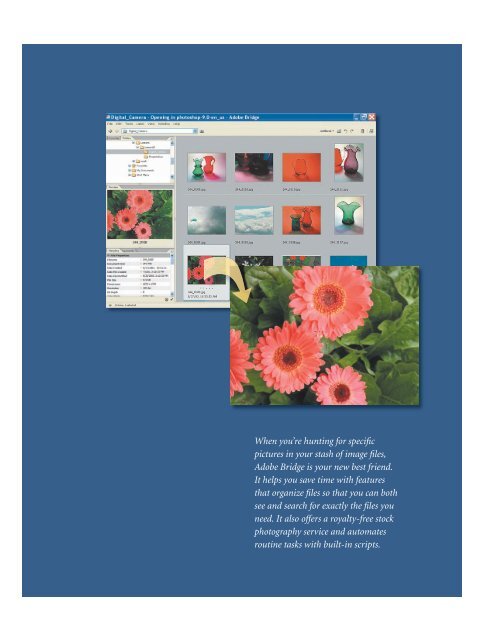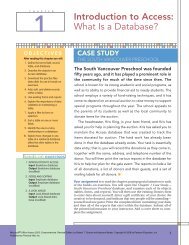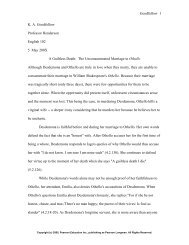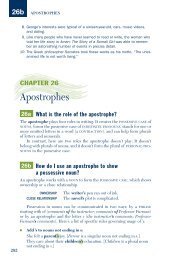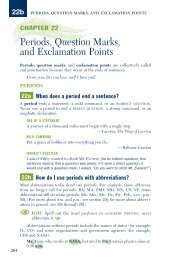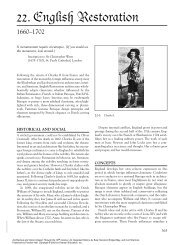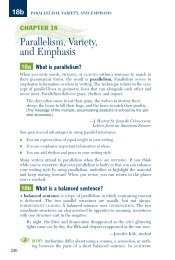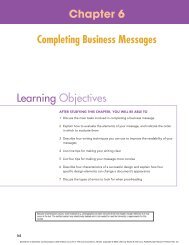Download - Pearson Learning Solutions
Download - Pearson Learning Solutions
Download - Pearson Learning Solutions
You also want an ePaper? Increase the reach of your titles
YUMPU automatically turns print PDFs into web optimized ePapers that Google loves.
When you’re hunting for specific<br />
pictures in your stash of image files,<br />
Adobe Bridge is your new best friend.<br />
It helps you save time with features<br />
that organize files so that you can both<br />
see and search for exactly the files you<br />
need. It also offers a royalty-free stock<br />
photography service and automates<br />
routine tasks with built-in scripts.
2 Using Adobe Bridge<br />
Lesson overview<br />
In this lesson, you’ll learn how to do the following:<br />
• Identify and resize Adobe Bridge palettes and panes.<br />
• Rotate, resize, and view thumbnail and preview image files.<br />
• Sort and rearrange thumbnails in the Bridge browser window.<br />
• Delete and batch-rename files in Adobe Bridge.<br />
• Assign star rankings, colored labels, metadata, and keywords to<br />
image files.<br />
• Search for image files based on criteria you define.<br />
• Create a Web gallery of images selected in Adobe Bridge.<br />
• Search for and download stock photography from Adobe Bridge.<br />
This lesson will take an hour to an hour and a half to complete. Copy the<br />
Lesson02 folder from the Adobe Photoshop CS2 Classroom in a Book CD<br />
into the Lessons folder on your hard drive that you set up earlier. As you<br />
work, you’ll overwrite some of the start files. To restore these original<br />
files, recopy them from the CD.<br />
Getting started<br />
You’ve already had a brief introduction to Adobe Bridge in Lesson 1,<br />
“Getting to Know the Work Area.” If you’ve completed that lesson, you<br />
know that the permanent Go to Bridge button ( ) on the Photoshop<br />
tool options bar takes you directly to Adobe Bridge. In this lesson, you<br />
will explore Adobe Bridge in depth. The aim of the first project for the<br />
lesson is to organize a motley collection of photographs.<br />
Adobe ® Photoshop ® CS2 Classroom in a Book ® . Copyright © 2005 by Adobe Systems Incorporated and its licensors. Published by Peachpit<br />
Press, a division of <strong>Pearson</strong> Education.
56<br />
LESSON 2<br />
Using Adobe Bridge<br />
Adobe Bridge shares some functionality with your desktop regarding files and folders.<br />
The changes you apply to files in Adobe Bridge change the files themselves, not merely<br />
the Adobe Bridge view of them. At the end of the lesson, you’ll experience how easy it<br />
can be to find specific images on your computer, as well as to browse and purchase stock<br />
photography using Adobe Bridge.<br />
1 Start Photoshop and then immediately hold down Ctrl-Alt-Shift (Windows) or<br />
Command-Option-Shift (Mac OS) to restore the default preferences. (See “Restoring<br />
default preferences” on page 6.)<br />
2 When prompted, click Yes to confirm that you want to reset preferences, and Close to<br />
close the Welcome Screen.<br />
3 Click the Go to Bridge button ( ) on the tool options bar to open Adobe Bridge.<br />
Note: You can also open Adobe Bridge by double-clicking its application icon on the<br />
desktop or by clicking it in the Dock (Mac OS), or by choosing Start > All Programs ><br />
Adobe Bridge (Windows).<br />
The Bridge browser window is the dashboard for a creative workflow. It provides the<br />
starting point for you to browse, locate, and preview your assets.<br />
Viewing and editing files in Adobe Bridge<br />
The left side of the browser window displays palettes that you can rearrange, resize, and<br />
group within Adobe Bridge, using the same techniques as with Photoshop palettes. The<br />
palettes in Adobe Bridge help you navigate, preview, search, and manage information<br />
for your image files and folders.<br />
Customizing Adobe Bridge views and spaces<br />
The ideal arrangement and relative sizes of items and areas of Adobe Bridge depend<br />
on your work style and preferences. Depending on the tasks you’re doing, it may be<br />
important to see what images are in a file; at other times, viewing information about<br />
the file may take priority. You can customize Adobe Bridge to increase your efficiency in<br />
these different situations.<br />
In this procedure, you’ll try out some of the custom views you can use in Adobe Bridge.<br />
The default configuration of Adobe Bridge areas appears in the following figure,<br />
although you won’t see these particular thumbnails onscreen yet.
ADOBE PHOTOSHOP CS2 57<br />
Classroom in a Book<br />
A<br />
B<br />
G<br />
H<br />
I<br />
C<br />
D<br />
J<br />
E<br />
F<br />
K<br />
L<br />
A. Menu bar B. Favorites palette C. Folders palette D. Preview palette E. Metadata palette<br />
F. Keywords palette G. Filter view menu H. Compact mode button I. Rotation buttons<br />
J. Thumbnail preview pane K. Thumbnail slider L. View option buttons<br />
Note: If you do not see the tabbed palettes on the left side of the browser window, click the<br />
Show/hide panels button ( ) in the lower left corner.<br />
1 Click the Folders tab in the upper left corner of the Bridge browser window to bring<br />
that palette forward, and navigate to the Lessons/Lesson02/Digital_Camera folder<br />
that you copied to your hard drive from the Adobe Photoshop CS2 Classroom in a Book<br />
CD. To navigate, either click the arrows (Mac OS) or plus signs (Windows) to open<br />
nested folders in the Folders palette, or double-click the folder thumbnail icons in the<br />
thumbnail preview area on the right side of the browser window.
58<br />
LESSON 2<br />
Using Adobe Bridge<br />
The Bridge preview pane updates interactively, showing you thumbnail previews of<br />
asset files. Adobe Bridge displays previews of image files such as those in PSD, TIFF, and<br />
JPEG formats as well as Adobe Illustrator vector files, multipage Adobe PDF files, and<br />
Microsoft Office documents.<br />
2 At the bottom of the browser window, drag the thumbnail slider to reduce and then<br />
enlarge the thumbnail previews. Then, choose the Details view, then the Filmstrip view.<br />
Details view<br />
Filmstrip view<br />
Note: Adobe Bridge also offers a Versions and Alternates view for those who work with<br />
Version Cue CS2. For more about Version Cue, see the “Understanding Adobe Version Cue<br />
CS2 File Manager” white paper on the Adobe Photoshop CS2 Classroom in a Book CD.
ADOBE PHOTOSHOP CS2 59<br />
Classroom in a Book<br />
3 Choose Window > Workspace > Lightbox. Then, in succession, choose the File<br />
Navigator, Metadata Focus, and Filmstrip Focus workspaces.<br />
Adobe Bridge can be customized to suit virtually any workflow or preference.<br />
4 When you’re finished experimenting, reset to the default workspace (press<br />
Command-F1 on the Mac or Ctrl-F1 in Windows).<br />
5 Select any thumbnail by clicking it once.<br />
A larger preview appears in the Preview palette, filling the available area.<br />
6 Enlarge the Preview palette by dragging the horizontal and vertical bars that separate<br />
it from the other panes of the browser window. The pointer appears as double lines with<br />
arrows ( ) when positioned over the bars.<br />
7 Continue to adjust the panes, palettes, and thumbnails in Adobe Bridge until the<br />
arrangement suits you.
60<br />
LESSON 2<br />
Using Adobe Bridge<br />
Adobe Bridge modes<br />
You can work in Photoshop with Adobe Bridge open in Full Mode in the background, at the<br />
ready for you to jump to and use to locate and open files. Or you can switch to Compact or<br />
Ultra-Compact mode by clicking those buttons in the upper right corner of the Bridge browser<br />
window. Both compact modes display Bridge as a floating palette over Photoshop. Ultra-Compact<br />
mode ( ) displays only the Go Back and Go Forward buttons as well as the Recent Folders menu.<br />
Compact mode ( ) shows thumbnail previews of the selected folder. As soon as you start to navigate<br />
to a folder in Ultra-Compact mode, Bridge automatically switches to Compact mode so that<br />
you can see thumbnail previews. Both modes provide a button to toggle back to Full mode ( ).<br />
Compact mode<br />
Ultra-Compact mode<br />
Rotating and opening images<br />
In addition to controlling the workspace and appearance of image previews in Bridge,<br />
you can also change the orientation of selected images and open them in Photoshop.<br />
Rotating the thumbnail previews in Adobe Bridge does not affect the resolution or<br />
quality of the files, but the rotation is permanent unless or until you undo it.<br />
1 Select the 244_0107.jpg thumbnail in the Lesson02/Digital_Camera folder.
ADOBE PHOTOSHOP CS2 61<br />
Classroom in a Book<br />
2 Click the Rotate 90˚ Counterclockwise button ( ) at the top of the browser window.<br />
3 In the thumbnail preview pane, select the 244_0111.jpg thumbnail.<br />
4 Click the Rotate 90˚ Clockwise button ( ).<br />
5 (Optional) To open any .PSD, .TIF, or .JPG image at any time into Photoshop from<br />
within Adobe Bridge, double-click its thumbnail preview.<br />
Note: Adobe Bridge will also automatically open .AI files into Adobe Illustrator, .PDF files<br />
into Adobe Acrobat, .INDD files into Adobe InDesign, and .DOC and .XLS documents into<br />
Microsoft Word and Microsoft Excel, respectively, if you have those applications. You can<br />
control file associations in Adobe Bridge preferences.
62<br />
LESSON 2<br />
Using Adobe Bridge<br />
You can select multiple thumbnails in Adobe Bridge and open or rotate them together.<br />
Select the files by using the usual methods: Click and then Shift-click, or drag the<br />
cursor across image thumbnails, to select contiguous files; or Ctrl-click (Windows) or<br />
Command-click (Mac OS) to select discontiguous images.<br />
Deleting images<br />
You can use Adobe Bridge to remove files or folders from your system exactly as you<br />
would remove them from your desktop. Deleting images in Adobe Bridge sends the files<br />
to the Recycle Bin (Windows) or Trash (Mac OS).<br />
Using Adobe Bridge to examine your images, you can confidently select and delete files<br />
that you no longer need or that you find unsatisfactory.<br />
1 Select the thumbnail for 244_0109.jpg, which is poorly composed, out of focus, and<br />
underexposed—a real loser.<br />
2 Click the Delete Item button ( ) at the top of the Bridge browser window. When a<br />
message appears asking you to confirm this action, click OK.<br />
At this point, the deleted file is not yet removed from your computer, although it is<br />
not visible in Adobe Bridge. You can find and retrieve deleted files by switching to the<br />
desktop and dragging them out of the Recycle Bin (Windows) or Trash (Mac OS). When<br />
you empty your desktop trash container, the files will be permanently deleted from your<br />
computer.<br />
Rearranging and renaming image files<br />
You can rearrange thumbnails in Adobe Bridge as freely as you might move negatives<br />
or slides on a light table. You can also use a batch-renaming process to give image files<br />
friendlier but well-organized filenames. In this exercise, you’ll rearrange the thumbnails<br />
according to subject matter—colored glass containers, flowers, and cloudy skies—and<br />
then rename them.<br />
1 In the thumbnail preview area of the browser window, drag the thumbnails of<br />
cloudy-sky photographs one by one until they are next to each other.
ADOBE PHOTOSHOP CS2 63<br />
Classroom in a Book<br />
2 Select the first sky thumbnail in the group and then Shift-click the last sky thumbnail<br />
to select the entire group.<br />
3 Choose Tools > Batch Rename.<br />
4 Under New Filenames in the Batch Rename dialog box, choose Text from the Current<br />
Filename pop-up menu, and type Clouds in the text field.<br />
5 Click the plus button ( )at the far right side of the New Filenames area, and choose<br />
Sequence Number from the pop-up menu. Make sure the default, 1, is selected for the<br />
starting sequence number, or type 1 now.<br />
6 Click the plus button to create a third criterion, and then choose New Extension<br />
from the pop-up menu. Type jpg (no period necessary) into the extension text field.<br />
(This preserves the .jpg file extension in the filename.)
64<br />
LESSON 2<br />
Using Adobe Bridge<br />
7 For Compatibility, select the check boxes for other operating systems: Windows,<br />
Mac OS, and Unix. (The operating system you are using will be dimmed but checked.)<br />
8 Review the sample in the Preview area to make sure that it reads “Clouds1.jpg,” and<br />
then click Rename.<br />
9 Choose View > Sort > By Filename to arrange the thumbnails in alphanumeric order.<br />
10 Using the techniques described in Steps 1–8, select and batch-rename the remaining<br />
photographs according to the subject matter pictured: flowers and ornamental<br />
glassware. When you set options in the Batch Rename dialog box, type Plants instead of<br />
Clouds to name the flower images, and type Glass for the glassware images. Otherwise,<br />
use the same options as in Steps 5–7.<br />
The Batch Rename command behaves differently depending on what is selected when<br />
you choose the command: If no thumbnails are selected, the naming scheme you specify<br />
in the Batch Rename dialog box applies the name change to all the files in the selected<br />
folder. If several—but not all—thumbnails are selected, the command renames only the<br />
selected files.<br />
Note: You can also rename a single file in Adobe Bridge in the conventional manner—that<br />
is, by clicking the filename in the thumbnail preview area and typing to overwrite the<br />
existing name.<br />
Embedding information for easy identification<br />
Adobe Bridge gives you numerous tools for retrieving the images you need to find.<br />
This is critical when you have a large number of stored images and no time to waste on<br />
browsing through hundreds or thousands of files.<br />
In this section, you’ll work with three more ways to embed information in files so that<br />
you can quickly find them later: rankings, metadata, and keywords.<br />
Ranking and sorting image files<br />
Adobe Bridge has a star-ranking feature that you can use to group and sort image<br />
thumbnails. This gives you an alternative way to organize images in the thumbnail<br />
preview area. In this exercise, five stars will stand for the best and most usable images,<br />
three stars for medium-quality images, and one star for the poorest-quality or least<br />
desirable photographs. How many stars you assign to each image is a personal
ADOBE PHOTOSHOP CS2 65<br />
Classroom in a Book<br />
judgment, so there are no right or wrong answers for star rankings, and—as opposed to<br />
the real world, perhaps—no one will take offense at your choices.<br />
1 Make sure you have large, clear thumbnail previews, and then click to select one<br />
that’s of particularly good quality, such as the red glass pitcher.<br />
2 Click one of the dots that appear below the image thumbnail. When you click, the<br />
dot turns into a star. Click to turn all five dots into stars.<br />
3 Select additional high-quality files, including one or two images in each category<br />
(glass, flowers, and skies).<br />
Note: Use Ctrl-click (Windows) or Command-click (Mac OS) to select discontiguous<br />
thumbnails, if desired.<br />
4 Choose Label > to apply the five-star ranking to all selected images at once.<br />
Click OK to dismiss the XMP warning dialog box if it appears.<br />
5 Choose View > Sort > By Rating to rearrange the thumbnails so that the best images<br />
are grouped together. Toggle off View > Sort > Ascending Order to have the five-starred<br />
images appear at the top of the thumbnail preview area.
66<br />
LESSON 2<br />
Using Adobe Bridge<br />
6 Continue to assign five-, three-, and one-star rankings to all the files in the folder,<br />
either by ranking them individually (as in Steps 1 and 2) or in multiples (as in Steps 3<br />
and 4).<br />
Note: You can delete stars at any time by selecting the thumbnail, moving the cursor over<br />
the stars, and clicking the gray circle with a slash through it ( ) that appears to the left.<br />
7 Choose View > Sort > By Rating again to arrange the files in reverse alphabetical<br />
order of their rankings.<br />
Quality is not the only consideration by which you might want to rank images. You can<br />
use star rankings to indicate anything—subject matter, client, project name, or time of
ADOBE PHOTOSHOP CS2 67<br />
Classroom in a Book<br />
day, for example. Indeed, if you want to organize your images by multiple factors—say,<br />
by quality and by project, you can also apply colored labels your images. Yellow labels<br />
might be applied to assets that will be used for a Web project, for example, while red<br />
labels could indicate that the image will be used for a print brochure.<br />
8 Click to select the thumbnail of any image, such as the red pitcher, and then choose<br />
Label > Yellow. Click OK to dismiss the XMP warning dialog box if it appears.<br />
A yellow label appears behind the five-star ranking of the thumbnail preview.<br />
9 Continue to assign colored labels—yellow or otherwise—to additional files in the<br />
folder, either by selecting them individually or in multiples and then choosing a color<br />
from the Label menu.<br />
Note: You can also apply colored labels by selecting one or more thumbnails and Controlclicking<br />
(Mac OS) or right-clicking (Windows) and choosing Label and a color from the<br />
contextual pop-up menu.<br />
10 Choose View > Sort > By Label to arrange the files in the thumbnail preview area by<br />
their colored labels.
68<br />
LESSON 2<br />
Using Adobe Bridge<br />
In addition to sorting your view by rankings and labels, you can filter the view to see only<br />
those thumbnails of a specific ranking or color. Let’s experiment with those filters now.<br />
11 Choose Show 5 Stars from the Unfiltered pop-up menu to show thumbnails of only<br />
those thumbnails with a five-star ranking.<br />
12 Choose Filtered > Show Red Label.<br />
13 Choose Filtered > Show All Items so that you can see all of your image files.<br />
Reviewing and editing metadata<br />
You can quickly see file information in one of several ways: Simply hover the mouse cursor<br />
over an image thumbnail in the Thumbnails view, and it will pop up; or switch to the<br />
Details view and the same metadata file information appears next to the image thumbnail<br />
preview. Or you can use the Metadata palette, which displays more complete metadata.<br />
Next, you will compare the two displays of metadata information.
ADOBE PHOTOSHOP CS2 69<br />
Classroom in a Book<br />
The information in the Metadata palette is nested under headings that you can expand<br />
or collapse by clicking the arrow next to a heading. There are three headings for images:<br />
File Properties, IPTC, and Camera Data (Exif). Additional headings are available for<br />
stock photo images. In Bridge, you can directly edit only some of the IPTC metadata.<br />
1 Make sure you’re in Details view, and click to select the thumbnail of one of the fivestarred<br />
glassware images.<br />
2 If necessary, click the Metadata tab to bring that palette forward in the lower left<br />
pane of the browser window. If any of the major headings are collapsed, click the arrows<br />
( ) to expand them so that you can compare the information here to the information<br />
listed in the Details view of the thumbnails.<br />
When you work with large amounts of metadata, it helps to enlarge the Metadata<br />
palette, even if it reduces or eliminates the Preview, Favorites, and Folders palettes. This<br />
can reduce the amount of scrolling needed to review and edit the information.<br />
3 Scroll down the Metadata palette to the IPTC heading so that you can see the items<br />
listed under it. The pencil icons ( ) on the left indicate items that you can edit.<br />
4 Click the blank space for Description and type a few words describing the image,<br />
such as red pitcher.
70<br />
LESSON 2<br />
Using Adobe Bridge<br />
5 At the bottom of the Metadata palette, click the Apply button ( ) to enter the<br />
information you typed.<br />
Creating and applying keywords<br />
Keywords can streamline your searches for images. If you have a large collection of<br />
images, the few seconds required to enter some well-chosen keywords can save you<br />
hours later as you try to locate specific images.<br />
The Keywords palette organizes keywords in categories that you can expand and<br />
collapse as you did on the Metadata palette. The Keywords palette standardizes<br />
keywords so that you can apply identical terms to specific types of images. This greatly<br />
reduces the risks of occasional typographical errors or inconsistencies that can turn<br />
keyword searches from a dream come true into a nightmare.<br />
1 Click the Keywords tab to bring that palette forward.<br />
2 Click the Keywords palette menu button ( ), and choose New Keyword Set. Or, click<br />
the New Keyword Set button ( ) at the bottom of the Keywords palette.<br />
3 Type Glass Project in the new blank to name the keyword set, and press Enter<br />
(Windows) or Return (Mac OS). Leave the Glass Project keyword set selected, or reselect<br />
it if necessary.
ADOBE PHOTOSHOP CS2 71<br />
Classroom in a Book<br />
4 Click the New Keyword button ( ) to create a keyword under the Glass Project<br />
category, type Red, and press Enter (Windows) or Return (Mac OS). Then, select the<br />
Glass Project category again and repeat the process until you have created five more new<br />
keywords, naming them Green, Blue, Orange, Purple, and Yellow.<br />
5 Select the thumbnail for the photograph of the green vase and the red pitcher.<br />
6 In the Keywords palette, click the boxes for both the Red and Green keywords to<br />
apply them to the image metadata. Or, double-click each of those keywords.<br />
A check mark appears next to the applied keywords. The bold hyphen next to the Glass<br />
Project category indicates that some (but not all) of the keywords in that set apply to the<br />
selected file.
72<br />
LESSON 2<br />
Using Adobe Bridge<br />
7 One by one, select each of the other glassware images and apply the appropriate<br />
keywords for the glass colors in those photographs. Or, you can select multiple files—<br />
such as all the images with blue glassware, if there are several—and simultaneously<br />
apply the keyword Blue to each of them.<br />
Deleting keywords<br />
The lists on the Keywords palette are application-wide, so the same keyword choices are<br />
available regardless of what folder you’re browsing. Many of the preset keywords may<br />
not be useful to you. Fortunately, you can delete keywords you won’t need. Since there is<br />
no orange glass in the images, you can delete Orange.<br />
You don’t have to worry about deleting a keyword that is currently applied to some<br />
files. In those cases, the keyword is deleted from the heading but shows up under a new<br />
heading named Other Keywords. You’ll see that in this exercise.<br />
1 In the Keywords palette, select the Orange keyword, and then click the Delete<br />
Keyword button ( ) at the bottom of the palette. Click OK to dismiss the warning<br />
that appears.<br />
2 Repeat Step 1, but this time delete the Red keyword.<br />
3 Select one of the thumbnails showing a red glass item. (You previously assigned Red<br />
to this file.)<br />
4 In the Keywords palette, find the Other Keywords category and locate the Red<br />
keyword. Drag the keyword back into the Glass Project category to group it with the<br />
other color keywords.
ADOBE PHOTOSHOP CS2 73<br />
Classroom in a Book<br />
You can also edit keywords. This is easy to do, but there’s a little trick to it. Since<br />
double-clicking a keyword applies it to any currently selected files, you need to select the<br />
keyword and then choose Rename from the Keywords palette menu or context menu.<br />
Then, type in your new text.<br />
Searching with Adobe Bridge<br />
Now that you’ve taken the time to associate information with the images in the<br />
Lesson02/Digital_Camera folder, you’re ready to see how easy this makes searching.<br />
1 Choose Edit > Find.<br />
2 In the Find dialog box, make sure that the Lesson02/Digital_Camera folder appears<br />
in the Look In option, or click Browse and navigate to that folder.<br />
3 Under Criteria, choose Filename > contains, and type Glass in the blank field.<br />
4 Click the plus-sign button ( ) to open another set of criteria menus.<br />
5 In the second row, choose Keywords > contains, and type Red.<br />
6 Click the plus-sign button to open a third row, and choose Rating > is equal to, and<br />
choose five stars.<br />
7 Click Find.
74<br />
LESSON 2<br />
Using Adobe Bridge<br />
Any files that match all three sets of criteria—that is, five-star-quality images of<br />
red glassware, if you’ve completed the previous tasks in this lesson—appear in the<br />
thumbnail preview area. Look at the Recent Folders menu, and notice that the current<br />
location is a new folder named Find Results.<br />
Julieanne Kost is an official Adobe Photoshop evangelist.<br />
T O O L T I P S F R O M T H E P H O T O S H O P E V A N G E L I S T<br />
Hi, I’m Julieanne Kost, a Photoshop evangelist for Adobe Systems. That simply means I lecture<br />
and teach courses on Adobe Photoshop, as well as use it for my own professional photography.<br />
Photoshop is a powerful application, and learning some key shortcuts and tricks not only adds to<br />
the functionality of the program but also lets you use it more freely and efficiently. So sprinkled<br />
throughout this book are some of my favorite tips and tricks, which I hope that you find useful.<br />
Keyboard shortcuts with Bridge<br />
Here are some tips to help you get a running start with Adobe Bridge:<br />
• To jump from Photoshop to Bridge using a keyboard shortcut, press Alt-Ctrl-O (Windows) or<br />
Option-Command-O (Mac OS).<br />
• In Thumbnails view, quickly navigate image thumbnails in the main preview area using the up,<br />
down, right, and left arrow keys.<br />
• Rotate one or more selected images 90 degrees clockwise by pressing Ctrl-] (Windows) or<br />
Command-] (Mac OS). Rotate 90 degrees counterclockwise by pressing Ctrl-[ (Windows) or<br />
Command-[ (Mac OS).
ADOBE PHOTOSHOP CS2 75<br />
Classroom in a Book<br />
Using Favorites and Collections<br />
Favorites and Collections are two organizational features that might help you right<br />
about now. Favorites are bookmarked locations on your hard drive or network that you<br />
can access with the click of a button. Collections are groups of images that you can access<br />
quickly from the Favorites palette.<br />
Let’s start by saving your search results as a collection so that you can easily locate all the<br />
five-star red glassware images in the future.<br />
1 Click the Save As Collection button at the top of the browser window ( ).<br />
2 In the Save Collection dialog box, name your collection 5-star red glassware, and<br />
then click Save.<br />
3 Click the Favorites tab to bring that palette forward if it’s behind the Folders palette,<br />
and resize to enlarge it if necessary for a better view.<br />
Favorites provide quick links to frequently visited locations. Be default, Bridge provides<br />
Favorites for your computer, desktop, and some other folders, such as Pictures and<br />
Documents. Another default Favorite is Collections, which can be any group of images<br />
or assets that you create, such as the results of your search.<br />
4 Click to select Collections in the Favorites palette, and then double-click the 5-star<br />
red glassware collections thumbnail to see thumbnail previews of the images in that<br />
collection.
76<br />
LESSON 2<br />
Using Adobe Bridge<br />
Now let’s create a custom favorite that will come in handy for the rest of the lessons of<br />
this book.<br />
5 Click the Folders tab to bring that palette forward, and navigate to the Lessons folder<br />
that contains all of the individual Classroom in a Book lesson folders.<br />
6 Select the Lessons folder (in the Folders palette or preview area) and choose File ><br />
Add to Favorites.<br />
Now, when you need to locate files for the other lessons in this book, you can click<br />
Lessons in the Favorites palette and double-click to open the folder in the preview area<br />
for the particular numbered lesson.<br />
Automating routine tasks<br />
The Adobe Bridge Tools menu includes a number of automated routines that also<br />
appear on the File > Automate menu in Photoshop. You’ll try out one of these now.<br />
The advantage of the automated commands in Bridge is that you can use them without<br />
even opening the files in Photoshop. You can apply these commands to all the files in a<br />
selected folder or to individual files in the folder that you select—it’s your choice.<br />
Creating a Web photo gallery<br />
The Web Photo Gallery command generates an entire Web site for you, with<br />
thumbnails, images, text, and even an area for review feedback that the user fills out
ADOBE PHOTOSHOP CS2 77<br />
Classroom in a Book<br />
on the site and e-mails to the alias you designate. You can choose from a generous<br />
assortment of predefined layouts and styles that you can customize.<br />
1 Click the Favorites tab to bring that palette forward, select Lessons, and then navigate<br />
to the Lesson02/Presentation folder.<br />
This folder contains five Ferris-wheel photographs; none of them are currently selected.<br />
2 Choose Tools > Photoshop > Web Photo Gallery.<br />
If Photoshop was closed, it will launch now. Otherwise, Bridge simply jumps to the<br />
open application. The Web Photo Gallery dialog box opens.<br />
3 In the Web Photo Gallery dialog box, do the following:<br />
• Choose Centered Frame 1- Feedback from the Styles pop-up menu.<br />
• Type your own e-mail address as the address at which you want to receive feedback<br />
from reviewers.<br />
4 Under Source Images, do the following, if they are not already done:<br />
• Choose Use > Folder.<br />
• Click the Browse button (Windows) or Choose button (Mac OS), and then verify<br />
that the Presentation folder is selected. Or, select it now.<br />
• Create a destination folder for your Web gallery: Click the Destination button,<br />
navigate to your desktop, and click the New Folder button. Type Wheel Web Site to
78<br />
LESSON 2<br />
Using Adobe Bridge<br />
name the folder, then click OK (Windows) or Create (Mac OS). You should return to<br />
the Web Photo Gallery dialog box.<br />
5 Under Options, use the pop-up menu to toggle through the General, Banner, Large<br />
Images, and Thumbnails categories, specifying the following options for each:<br />
• General: Choose .html from the Extension pop-up menu, and deselect all three<br />
check boxes.<br />
• Banner: Type Ferris Wheel Photos for Site Name, Adobe Systems for photographer,<br />
and today’s date (if necessary) or another date. You can leave the Contact Info option<br />
blank or type any phone number or street address.<br />
• Large Images: Select the Resize Images check box (if necessary), choose Large from<br />
the pop-up menu, and leave the other options at the default settings.<br />
• Thumbnails: Select Custom from the Size pop-up menu, and type 70 pixels. Leave<br />
the other options at the default settings.<br />
Because you’ll accept the default settings for Custom Colors and Security, you don’t<br />
need to visit those categories.<br />
6 Click OK.<br />
Photoshop automatically opens the files and creates the resources for the Web gallery,<br />
and then the gallery opens in your default Web browser application.
ADOBE PHOTOSHOP CS2 79<br />
Classroom in a Book<br />
Reviewers can click any thumbnail at left to view a larger preview at right. Clicking<br />
the Image Info tab displays information about the selected image. Clicking the Image<br />
Feedback tab lets reviewers comment on or approve the image, and e-mail their<br />
comments to you.<br />
Web Photo Gallery is just one of several automated tasks you can perform in Adobe<br />
Bridge. You can explore the others when you have time.<br />
7 Close your browser and return to Bridge.<br />
Acquiring stock photography<br />
In addition to using Adobe Bridge to organize and locate your own image assets, you<br />
can use it to browse and purchase royalty-free stock photography. This is because Adobe<br />
Bridge includes a service called Adobe Stock Photos, which provides one-stop shopping<br />
for thousands of royalty-free digital images from numerous stock agencies. You can use<br />
Adobe Stock Photos to conduct searches, download comps, and purchase images, all<br />
from within Adobe Bridge.<br />
Browsing and searching for stock images<br />
As the designer on the Ferris wheel project, let’s pretend you’ve decided to go on a hunt<br />
for additional images of Ferris wheels.<br />
1 In the Favorites palette of Adobe Bridge, click Adobe Stock Photos.
80<br />
LESSON 2<br />
Using Adobe Bridge<br />
The home page for Adobe Stock photos highlights new content and lets you browse and<br />
search for royalty-free stock content.<br />
2 In the search box at the top of the page, type the keywords ferris wheel, and then<br />
press Enter (Windows) or Return (Mac OS), or click the Start Search button.<br />
Adobe Stock Photos search results appear in the Bridge browser window, offering all<br />
of the same customizable previews controls, including scalable thumbnails, that are<br />
available to local image files.
ADOBE PHOTOSHOP CS2 81<br />
Classroom in a Book<br />
<strong>Download</strong>ing and purchasing stock photos<br />
Next, download a low-res comp.<br />
1 With an image thumbnail selected (or two or three thumbnails), click the <strong>Download</strong><br />
Comp button ( ).<br />
Comps may be downloaded for free from Adobe Stock Photos and used without<br />
watermarked logos in layouts and proofs. Comps are saved to the <strong>Download</strong>ed Comps<br />
folder, which is in the My Documents/Adobe Stock Photos folder (Windows) or<br />
Documents/Adobe Stock Photos folder (Mac OS).<br />
2 In the Favorites palette, click <strong>Download</strong>ed Comps to see your comps.<br />
To open these comps in Photoshop, simply double-click on a thumbnail preview as you<br />
would any other image file. You can also rename downloaded comps more intuitively,<br />
move them to other folders on your hard drive or network, and even place them in page<br />
layout files. Adobe Stock Photos preserves the original file information so that when<br />
you’re ready to purchase an image, you can do it from Bridge.<br />
3 To purchase any image, select its thumbnail preview and click the Add to Cart button<br />
( ).<br />
Note: You will be prompted to choose a country the first time you try to purchase a stock<br />
photo. Choose from among the 27 countries in the pop-up menu, then click Continue.<br />
4 When Adobe Stock Photos tells you that the image has been added to your cart, click<br />
the View Shopping Cart button to see what’s there.
82<br />
LESSON 2<br />
Using Adobe Bridge<br />
Adobe Stock Photos has added a low-resolution version of the image to your cart.<br />
You can delete images from your shopping cart, choose a different size or resolution,<br />
continue shopping, or proceed to checkout from the shopping cart page. Adobe Stock<br />
Photos lets you purchase images as a guest, or you can set up an account. Either way,<br />
you can purchase images from multiple stock photo libraries in a single transaction. All<br />
purchased images are placed in the Purchased Images folder.<br />
Congratulations—you’ve finished this lesson on Adobe Bridge. As you work through<br />
this book, you’ll have many more opportunities to use Bridge and to discover what a<br />
time-saver it can be.
Review<br />
Review questions<br />
1 Describe three ways to display Adobe Bridge.<br />
2 What are some of the similarities between working with folders and files on<br />
the desktop and working with them in Adobe Bridge?<br />
3 How can you customize the browser window and thumbnail previews in<br />
Adobe Bridge?<br />
4 What are the advantages of using Adobe Bridge instead of a desktop folder?<br />
Review answers<br />
1 You can display Adobe Bridge in Full mode as a regular application, or toggle<br />
to Ultra-Compact or Compact mode. The compact modes display Bridge as a<br />
floating palette over other applications.<br />
2 You can use either Adobe Bridge or a desktop folder—such as the Explorer<br />
(Windows) or the Finder (Mac OS)—to rename files, move files into the Recycle<br />
Bin (Windows) or Trash (Mac OS), move files and folders from one location to<br />
another, rename files and folders, and create new folders.<br />
3 You can rearrange the palettes on the left side of the Adobe Bridge browser<br />
window by dragging their tabs, and you can resize panes by dragging their<br />
edges. You can enlarge and reduce thumbnail previews on the right side of the<br />
browser window by dragging the thumbnail slider, and you can choose between<br />
Thumbnail, Details, and Filmstrip views, depending on personal preference.<br />
4 Adobe Bridge shows high-resolution, scalable thumbnail previews of image<br />
files as well as metadata information about the selected item. You can apply a<br />
number of changes to files in Bridge without having to open them in Photoshop;<br />
for example, you can rotate them. You can also use Bridge to assign star rankings<br />
and colored labels to files, to sort files by various criteria, and to batch-rename<br />
files. Finally, you can perform automated functions in Adobe Bridge, such as<br />
creating Web photo galleries, and you can browse and purchase royalty-free<br />
digital stock photography.


